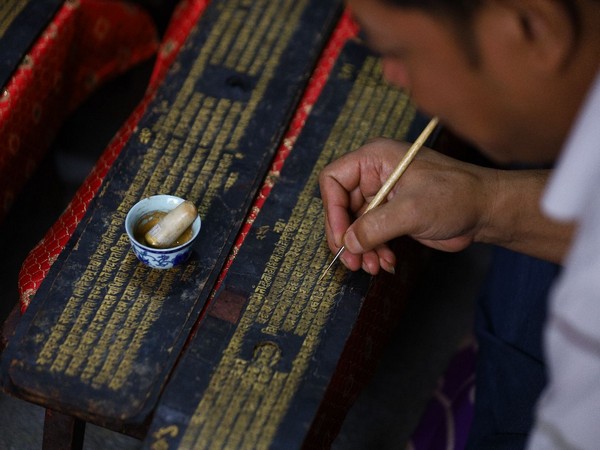
Lalitpur: In the courtyards of the Golden Temple in the ancient Patan Durbar Square of Nepal, around half a dozen artists are renovating an eight-centuries-old Buddhist manuscript with gold.
The 800 years old “Pragya Paramita” Buddhist scripture is being renovated by artists by reinstating the faded words and rewriting those damaged over the course of time. All the scripts in this holy manuscript are in the “Ranjana” script (the oldest form of Newa: scripture) and are written with gold.
Believed to have been first inscribed during Abhaya Malla’s regime before the unification of modern Nepal, the scripture is believed to have been prepared by Ananda Bhichhu (monk).
Kept in the Golden Temple at other times and recited on a daily basis, the Pursottam Maas (also called Mala Maas) gives a break to daily recitation when the artists gather together to renovate the ancient manuscript.
The artist involved in the renovation of the antique Buddhist manuscript, Hem Ratna Bajracharya told ANI, “Currently we are renovating the ‘Pragya Paramita’ written with gold. It is read out on a daily basis which has caused the gold to fade out and tear off. We are renovating it."
The word “Pragya” means ‘intellect’ and “Paramita” means ‘wholeness’ thus making the meaning intellectual wholeness. It is followed and read in those countries which follow Mahayana Buddhism which aims to secure enlightenment.
In this golden word manuscript, the eight thousand verses delivered by Gautam Buddha to one thousand three hundred and fifty disciples are recorded. It is believed that Buddha delivered those verses some 2500 years before.
“Following the ancient tradition of renovating it during the month of Mala Maas- Purusottam Maas. It has been followed since the past because for a month no religious functions are performed- based on this folklore, we have been renovating it. It is my tenth renovation, previously it used to be done by our father and forefathers and we have been following it since then,” Bajracharya said.
The month which does not have Surya Sakranti is called Mala Maas or Purusottam Maas which means there is no solstice of the Sun between one Aunsi “Amavasya” to another “Amavasya”. Sankranti means the entry of the Sun from one zodiac to another. Purusottam Maas comes with a difference of 32 months, 16 days and 6 hours.
It is another fact that the solar year is of 365 days and about six minutes and the lunar year is of 354 days. Thus, there is an interval of 11 days, 1 hour, 31 minutes and 12 seconds in both solar and lunar years. As this difference widens every year, it goes from three years to one month which is called Mala Maas.
This Buddhist manuscript in case of tearing or permanent damage beyond repair is rewritten on a special “Lokta” commonly known as “Nepali Kagaj” and locally known as “Nilpatra” which is made from the fibres of a plant called “Daphne Papyracea”- only found in Nepal. The paper is dyed in very dark blue ink which on drying almost appears black with has the special ability of being strong and retaining the special gold ink used to write the text very well.
The artists work every morning for about three hours and 30 minutes on a daily basis to renovate the manuscript for a month. The gold is converted into fine dust which is mixed with boiled flaxseed.
Bajracharya said, “In the Newari language we call it ‘Cholo’ the fine-dusted form of gold which is in the form of a sheet and is highly dissolvable in water and a special glue using the flaxseed is mixed in proportionate ratio to make the ink. If there is a variation in ratio then the writing becomes tougher as the gold is heavy and doesn’t spread."
"In case of disproportionate ratio, the gold would form a lump and writing get stalled. That’s why specially trained persons are involved in the preparation of ink," he added.